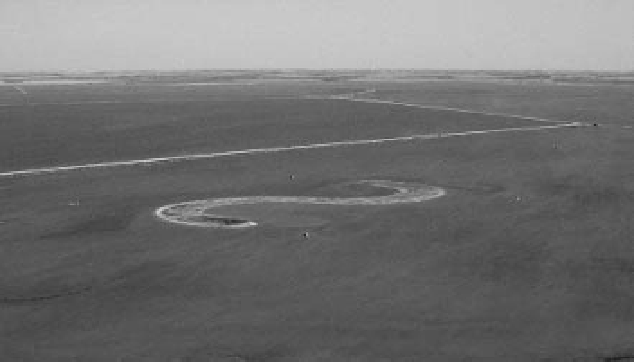Geoscience Reference
In-Depth Information
Figure 12-5.
S-shaped artii cial island for bird habitat in l ooded pools at the state Cheyenne Bottoms Wildlife Area.
Levees in the background are part of an extensive system to control water levels in various pools for habitat
management. Kite airphoto by J.S. Aber and P. and J. Johnston; central Kansas, United States.
Supplementary mechanical methods of con-
trolling plant species distributions and cover
types in wetlands include mowing, disking, and
plowing (see Fig. 6-36). Such practices are gen-
erally undertaken to mimic more natural pro-
cesses such as grazing and burning, and to
create suitable foraging and nesting bird and
animal habitat. Disking breaks up sod and low
vegetation and aerates the soil surface (Kent
2000b). Mechanical methods may also be effec-
tive in controlling problematic vegetation and
altering vegetation assemblages (Laubhan and
Roelle 2001).
example, in the Pantanal, seasonally wet grass-
lands occupy close to 30 percent of the total
area and low-intensity cattle ranching has been
a part of this landscape for more than 200 years
(Mourao et al. 2005). Increasing population pres-
sures, however, could rapidly change this sce-
nario as deliberate manipulation of water levels
and more sustained and intensive grazing prac-
tices promote wetland conversions into pasture
land. Overgrazing may also be detrimental to
wetland habitats, due to trampling and soil com-
paction, and when forage areas are signii cantly
depleted dependent bird communities experi-
ence shortages (Boojh, Patry and Smart 2008).
Flora and fauna are often actively managed
at wetland sites across the world. For instance,
stocking is undertaken to support local i sher-
ies, maintain adequate supplies for recreational
purposes (Fig. 12-6) or ecological balance, and
sustain threatened or endangered species (Wel-
comme et al. 2006b). Propagation is another
method whereby sections of wetlands are arti-
i cially seeded through transplants, cuttings,
tubers, or rhizomes (Kent 2006b). Local species
are generally selected for this purpose and their
suitability to the biotic and hydrologic charac-
teristics of the site are closely assessed before
propagation is undertaken (Kent 2006b). As
chapter 6 illustrates, species are also managed
to control troublesome and persistent invasive
populations.
12.4.2 Biological and chemical strategies
Domesticated and wild animals graze in wet-
lands across the world and provide an important
contributing factor in maintaining vegetation
structure in terms of height, density, and plant
species distributions (Laubhan and Roelle 2001).
Grazing may also be effective in managing inva-
sive species, helping control the spread of
aquatic plants, and maintaining the biological
diversity of wetlands.
Spartina patens
(salt hay)
dominates coastal marshes along the northeast-
ern coast of the United States that traditionally
served as cattle-grazing areas (see Figs. 11-1 and
11-2).
Floodplain grasslands have also been invalu-
able to dependent ranching communities. For





